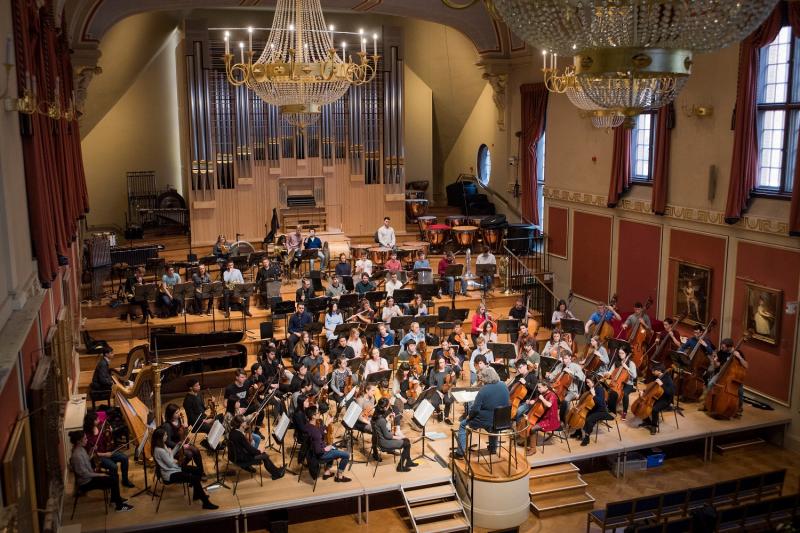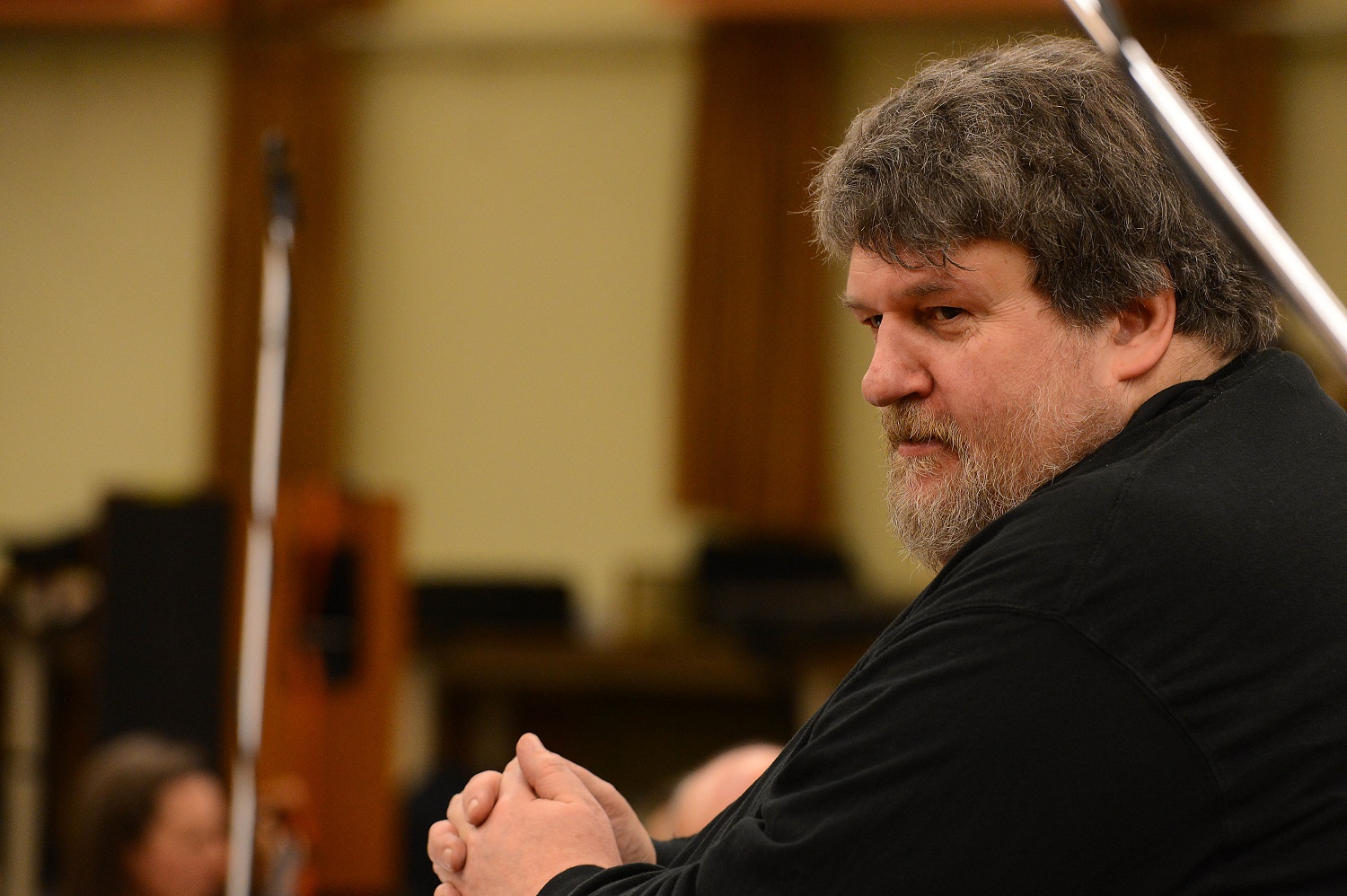Royal Academy of Music SO, Knussen, RAM review – vibrant, varied Stravinsky | reviews, news & interviews
Royal Academy of Music SO, Knussen, RAM review – vibrant, varied Stravinsky
Royal Academy of Music SO, Knussen, RAM review – vibrant, varied Stravinsky
The composer's early and late works proves an ideal showcase for the young orchestra

Oliver Knussen and the Royal Academy of Music Symphony Orchestra here took us on a whistle-stop tour of Stravinsky, early and late. Few composers changed so in style so dramatically over the course of their career, so there was plenty of variety here. And just for good measure, a work by Stravinsky’s teacher Rimsky-Korsakov was included too, his Russian Easter Festival Overture.
The Academy Symphony Orchestra is an impressively unified ensemble, and it’s only in the smallest details that you hear anything below professional standard. The string ensemble is almost faultless, and the flexibility and nimbleness of the string playing is also very impressive. The woodwinds and brass can be a little less precise in ensemble and tuning, but every section fields a dazzling soloist, especially the upper woodwinds. Knussen (pictured below, by Mark Allen/BBC) gave clear indications throughout, but with modest gestures, giving an air of gentle guidance rather than imposed authority.
The Russian Easter Festival Overture was an imposing opener. Knussen’s tempos were steady, and the many quotations from Orthodox chant were intoned as weighty declamations. Some shaky ensemble from the lower woodwinds made for an uncertain start, but they soon found their form. There were excellent solos here too, from the agile violin turns of leader Eriko Nagayama to the suitably stentorian trombone of Alberto Belzunegui Moreno.
Stravinsky’s 1908 Funeral Song is a natural companion to the Rimsky-Korsakov, being dedicated to the older composer and very much in his style. It has been doing the rounds since the score was rediscovered in 2015, and is now becoming established as one of the finest works of Stravinsky’s early period. The piece is based on a short motif, which is passed around the orchestra, so it is another good showcase for the various sections. Again, Knussen took a steady pace, and the wind players rose to the challenge, supporting well the long, exposed lines. That range of colour from the stings was also put to good use, with Stravinsky’s shimmering accompaniment textures subtly varied from one section to the next. Variations: Aldous Huxley in memoriam shot us to the far end of Stravinsky’s career, to 1964. Like many of Stravinsky’s late scores, this one is short and terse, but it’s colourful and varied too, the master orchestrator yet again finding ingenious ways to spotlight every corner of the ensemble. Knussen led an agile and brightly coloured reading, full of rhythmic zest and light, clean accents. As is customary with this short work, it was immediately encored, though it sounded crisper the first time round.
Variations: Aldous Huxley in memoriam shot us to the far end of Stravinsky’s career, to 1964. Like many of Stravinsky’s late scores, this one is short and terse, but it’s colourful and varied too, the master orchestrator yet again finding ingenious ways to spotlight every corner of the ensemble. Knussen led an agile and brightly coloured reading, full of rhythmic zest and light, clean accents. As is customary with this short work, it was immediately encored, though it sounded crisper the first time round.
The Firebird (here in the 1945 Suite version) made for a grand climax to the evening. Programming it with Funeral Song, which was written just a year before, invited revealing comparisons. The soft cello arpeggios that open the Firebird have a clear precedent in the Funeral Song, as do the many brief lower woodwind solos later on, and the doleful horn in the finale. Knussen pushed the players here, with faster tempos and louder dynamics, and for the most part they rose to the challenge. The brass lacked tonal control in Infernal Dance, and the strings weren’t quiet enough under the bassoon solo in the Berceuse. But all were back on form for the suitably expansive Final Hymn. All solos were well taken, with special mentions to Nagayama (again), cello Charlotte Kaslin, oboe Eleanor Sullivan and horn Ben Hulme. One last laurel too for Oliver Knussen, who is Professor of Composition at the Royal Academy, as of 2016. Here’s hoping that appointment will lead to more conducting, as his appearances with professional orchestras these days are all too rare.
rating
Explore topics
Share this article
The future of Arts Journalism
You can stop theartsdesk.com closing!
We urgently need financing to survive. Our fundraising drive has thus far raised £49,000 but we need to reach £100,000 or we will be forced to close. Please contribute here: https://gofund.me/c3f6033d
And if you can forward this information to anyone who might assist, we’d be grateful.

Subscribe to theartsdesk.com
Thank you for continuing to read our work on theartsdesk.com. For unlimited access to every article in its entirety, including our archive of more than 15,000 pieces, we're asking for £5 per month or £40 per year. We feel it's a very good deal, and hope you do too.
To take a subscription now simply click here.
And if you're looking for that extra gift for a friend or family member, why not treat them to a theartsdesk.com gift subscription?
more Classical music
 Kaploukhii, Greenwich Chamber Orchestra, Cutts, St James's Piccadilly review - promising young pianist
A robust and assertive Beethoven concerto suggests a player to follow
Kaploukhii, Greenwich Chamber Orchestra, Cutts, St James's Piccadilly review - promising young pianist
A robust and assertive Beethoven concerto suggests a player to follow
 Robin Holloway: Music's Odyssey review - lessons in composition
Broad and idiosyncratic survey of classical music is insightful but slightly indigestible
Robin Holloway: Music's Odyssey review - lessons in composition
Broad and idiosyncratic survey of classical music is insightful but slightly indigestible
 Classical CDs: Wolf-pelts, clowns and social realism
British ballet scores, 19th century cello works and contemporary piano etudes
Classical CDs: Wolf-pelts, clowns and social realism
British ballet scores, 19th century cello works and contemporary piano etudes
 Bizet in 150th anniversary year: rich and rare French offerings from Palazzetto Bru Zane
Specialists in French romantic music unveil a treasure trove both live and on disc
Bizet in 150th anniversary year: rich and rare French offerings from Palazzetto Bru Zane
Specialists in French romantic music unveil a treasure trove both live and on disc
 Scottish Chamber Orchestra, Ibragimova, Queen’s Hall, Edinburgh review - rarities, novelties and drumrolls
A pity the SCO didn't pick a better showcase for a shining guest artist
Scottish Chamber Orchestra, Ibragimova, Queen’s Hall, Edinburgh review - rarities, novelties and drumrolls
A pity the SCO didn't pick a better showcase for a shining guest artist
 Kilsby, Parkes, Sinfonia of London, Wilson, Barbican review - string things zing and sing in expert hands
British masterpieces for strings plus other-worldly tenor and horn - and a muscular rarity
Kilsby, Parkes, Sinfonia of London, Wilson, Barbican review - string things zing and sing in expert hands
British masterpieces for strings plus other-worldly tenor and horn - and a muscular rarity
 From Historical to Hip-Hop, Classically Black Music Festival, Kings Place review - a cluster of impressive stars for the future
From quasi-Mozartian elegance to the gritty humour of a kitchen inspection
From Historical to Hip-Hop, Classically Black Music Festival, Kings Place review - a cluster of impressive stars for the future
From quasi-Mozartian elegance to the gritty humour of a kitchen inspection
 Shibe, LSO, Adès, Barbican review - gaudy and glorious new music alongside serene Sibelius
Adès’s passion makes persuasive case for the music he loves, both new and old
Shibe, LSO, Adès, Barbican review - gaudy and glorious new music alongside serene Sibelius
Adès’s passion makes persuasive case for the music he loves, both new and old
 Anja Mittermüller, Richard Fu, Wigmore Hall review - a glorious hall debut
The Austrian mezzo shines - at the age of 22
Anja Mittermüller, Richard Fu, Wigmore Hall review - a glorious hall debut
The Austrian mezzo shines - at the age of 22
 First Person: clarinettist Oliver Pashley on the new horizons of The Hermes Experiment's latest album
Compositions by members of this unusual quartet feature for the first time
First Person: clarinettist Oliver Pashley on the new horizons of The Hermes Experiment's latest album
Compositions by members of this unusual quartet feature for the first time
 Gesualdo Passione, Les Arts Florissants, Amala Dior Company, Barbican review - inspired collaboration excavates the music's humanity
At times it was like watching an anarchic religious procession
Gesualdo Passione, Les Arts Florissants, Amala Dior Company, Barbican review - inspired collaboration excavates the music's humanity
At times it was like watching an anarchic religious procession

Add comment